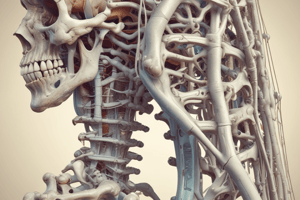Podcast
Questions and Answers
What are the primary functions of the skeletal system? (Select all that apply)
What are the primary functions of the skeletal system? (Select all that apply)
- Storage of Minerals (correct)
- Hormone Production
- Support (correct)
- Blood Cell Production (correct)
How many bones are in the axial skeleton?
How many bones are in the axial skeleton?
80
The appendicular skeleton includes the bones of the skull.
The appendicular skeleton includes the bones of the skull.
False (B)
Name the four types of cells found in bone tissue.
Name the four types of cells found in bone tissue.
The process by which bone continually remodels, recycles, and replaces itself is known as _____ remodeling.
The process by which bone continually remodels, recycles, and replaces itself is known as _____ remodeling.
What happens to bones when there is more breakdown than building activity?
What happens to bones when there is more breakdown than building activity?
What role do osteoblasts play in bone health?
What role do osteoblasts play in bone health?
Heavily stressed bones become thinner and weaker.
Heavily stressed bones become thinner and weaker.
What is one of the primary functions of the skeletal system?
What is one of the primary functions of the skeletal system?
How many bones are in the axial skeleton?
How many bones are in the axial skeleton?
What are the four types of bone cells?
What are the four types of bone cells?
Osteoblasts are responsible for the resorption of bone matrix.
Osteoblasts are responsible for the resorption of bone matrix.
The appendicular skeleton includes ____ bones.
The appendicular skeleton includes ____ bones.
What happens to bones when there is more breakdown than building?
What happens to bones when there is more breakdown than building?
What is the role of osteocytes?
What is the role of osteocytes?
Exercise has no effect on bone density.
Exercise has no effect on bone density.
What occurs during the process of bone remodeling?
What occurs during the process of bone remodeling?
Match the following components of the skeletal system with their descriptions:
Match the following components of the skeletal system with their descriptions:
Flashcards are hidden until you start studying
Study Notes
Review of Musculoskeletal System
- Includes bones, cartilages, ligaments, and connective tissues
- Supports the body and stores minerals and lipids (yellow marrow)
- Produces blood cells (red marrow)
- Provides protection for vital organs
- Offers leverage for movement
Axial Skeleton
- Forms the body's longitudinal axis
- Contains 80 bones
- Includes the skull, auditory ossicles, and hyoid bone
Appendicular Skeleton
- Contains 126 bones
- Enables movement and manipulation of objects
- Includes the limbs and supportive girdles
Bone Tissue
- Contains four types of cells: osteocytes, osteoblasts, osteoprogenitor cells, and osteoclasts
- Osteocytes: mature bone cells that maintain the bone matrix and release calcium into the blood
- Osteoblasts: build bone by synthesizing and secreting organic matrix, participating in calcification
- Osteoprogenitor cells: undifferentiated cells that differentiate into osteoblasts, found in various areas of growing bones
- Osteoclasts: break down bone matrix, releasing calcium and phosphate
Bone Homeostasis
- Maintaining a balance between bone building (osteoblasts) and bone recycling (osteoclasts)
- Excessive breakdown compared to building weakens bones
- Weight-bearing exercise stimulates bone building by osteoblasts
Bone Remodeling
- The adult skeleton constantly remodels, recycles, and replaces bone
- Turnover rate varies, adjusting based on deposition and removal of bone matrix
- Deposition greater than removal strengthens bones, while removal exceeding deposition weakens bones
- Involves the cooperation of osteocytes, osteoblasts, and osteoclasts
Effects of Exercise, Hormones, and Nutrition
- Exercise (especially weight-bearing) strengthens bones by increasing mineral recycling and stimulating osteoblast activity
- Bone degeneration occurs quickly without sufficient exercise and can lead to bone loss
Musculoskeletal System Review
- The skeletal system is composed of bones, cartilages, ligaments, and connective tissues.
- The skeletal system's primary functions include support, mineral storage, blood cell production, protection, and leverage for movement.
- The axial skeleton forms the body's longitudinal axis and consists of 80 bones, including the skull, auditory ossicles, and hyoid bone.
- The appendicular skeleton consists of 126 bones and enables movement and manipulation of objects. It includes the limbs and supportive girdles.
Bone Tissue
- Bone tissue contains four types of cells: osteocytes, osteoblasts, osteoprogenitor cells, and osteoclasts.
- Osteocytes are mature bone cells that maintain bone matrix and regulate calcium release.
- Osteoblasts are bone-forming cells that synthesize and secrete organic matrix, participating in the calcification process.
- Osteoprogenitor cells are undifferentiated cells that can differentiate into osteoblasts.
- Osteoclasts are responsible for bone matrix resorption, releasing calcium and phosphate from bone.
Bone Homeostasis and Remodeling
- Bone homeostasis involves a balance between bone building by osteoblasts and bone recycling by osteoclasts.
- Weight-bearing exercise stimulates osteoblast activity and increases bone strength.
- Continuous bone remodeling occurs throughout life, with varying turnover rates depending on factors like stress and mineral deposition.
Effects of Exercise, Hormones, and Nutrition
- Exercise, especially weight-bearing exercise, strengthens bones by stimulating osteoblast activity.
- Bone degeneration occurs rapidly when there is a lack of stress or exercise.
- Nutrition plays a crucial role in bone health, with calcium and vitamin D being essential for bone formation and maintenance.
Hormone Impact on Bone
- Hormones like growth hormone, thyroid hormone, and sex hormones are involved in bone growth and metabolism.
- Parathyroid hormone (PTH) regulates calcium levels in blood.
- Calcitonin regulates calcium deposition in bone.
Studying That Suits You
Use AI to generate personalized quizzes and flashcards to suit your learning preferences.




